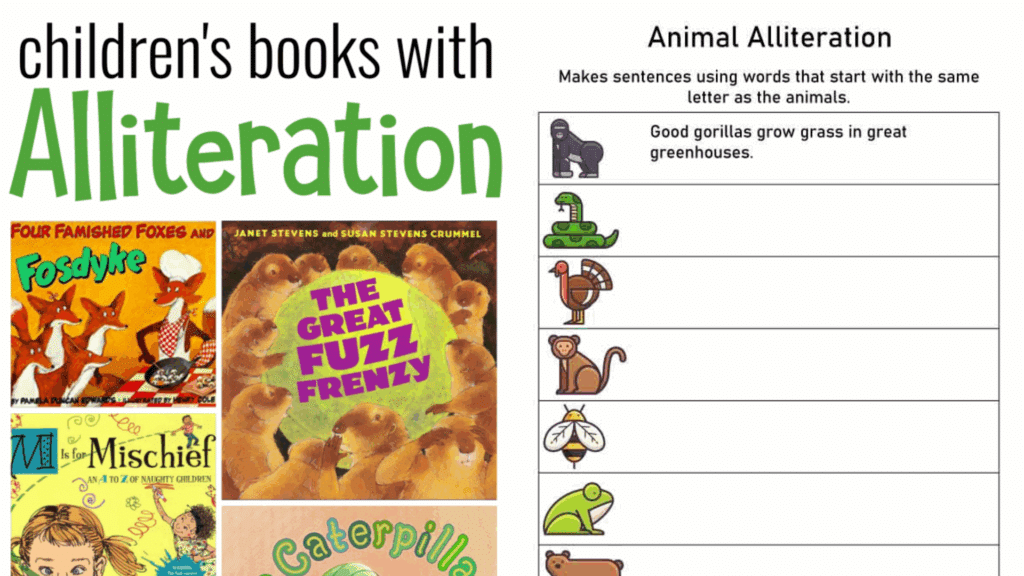Learning a language can feel like a challenge, especially when traditional methods make it boring. Most students struggle to remember new words and sounds.
But what if I told you that simple word games could change everything?
Alliteration exercises offer a fun way to boost memory, improve pronunciation, and build vocabulary. Children and adults both love the musical quality of repeated sounds.
This blog will show you engaging alliteration activities, practical tools, and teaching methods that make language learning enjoyable.
Why Use Alliteration in the Classroom?
Teachers often search for methods that make learning stick. Alliteration helps students remember information better because our brains process patterns more easily than random words.
When children hear “big brown bear,” the repeated ‘b’ sound creates a mental hook that improves recall. This technique also sharpens pronunciation skills.
Students practice specific sounds repeatedly, which builds muscle memory in their mouths and tongues. Research shows that phonemic awareness, the ability to hear and work with individual sounds, improves significantly through alliteration practice.
Beyond the technical benefits, alliteration simply makes learning fun. Students laugh, participate more, and stay focused longer when lessons include playful language patterns.
Alliteration Activities to Make Learning Fun

1. Alliteration Alphabet Book
Have students create an alphabet book where each page features a letter and an alliterative phrase or sentence, such as “A is for amazing apples in autumn” or “B is for bouncing bunnies in the backyard.”
This activity reinforces letter sounds and encourages creativity.
2. Tongue-Twist-Trade Game
Prepare slips of paper with different tongue twisters or alliterative phrases.
Students pair up, read their phrases to each other, trade slips, and quickly find a new partner to repeat the process. This helps with fluency and makes alliteration fun.
3. Alliterative Name Sentences
Each student creates a sentence using their name and as many alliterative words as possible, e.g., “Silly Sam sings songs on Saturdays.”
This can be done individually or as a group activity where classmates help brainstorm words.
4. Crazy Menu or Jellybean Jumble
Students invent silly menu items or jellybean flavors using alliteration, such as “crunchy cabbage caterpillar jelly bean” or “mouthwatering monkey muffins.” This activity boosts vocabulary and imagination.
5. Alliterative Poem or Story Writing
Challenge students to write a short poem or story using alliteration. They can focus on a particular letter or sound, or write about a favorite topic, like sports or animals, using repeated initial consonants.
Creative Resources for Alliteration Learning

Learning becomes easier when you have the right tools at your fingertips. Teachers and parents can choose from many resources that make alliteration practice engaging and effective.
Alliteration in Storybooks and Literature
Children’s books provide natural alliteration examples that feel fun rather than forced. Reading these books aloud helps students hear rhythm and flow.
These authors master the art of playful language:
| Author | Books | Alliteration Style |
|---|---|---|
| Dr. Seuss | “Fox in Socks,” “Green Eggs and Ham” | Abundant sound patterns |
| Shel Silverstein | “Where the Sidewalk Ends” | Memorable alliterative verses |
| Chris Van Allsburg | Picture books | Subtle alliteration for older students |
Tech-Based Learning Tools
Digital tools bring alliteration into the modern classroom. Students respond well to interactive technology:
- ABCmouse – Interactive games and songs to teach letters and sounds, ideal for reinforcing alliteration.
- Epic! – A digital library with books that feature alliteration, perfect for engaging young readers.
- Starfall– Focused on phonics and early literacy, offering interactive activities that include alliterative words.
- Raz-Kids – A reading app with stories that help kids practice recognizing and using alliteration.
- Reading Eggs– Offers phonics lessons and activities that incorporate alliteration into fun, interactive learning.
Printables, Worksheets, and Flashcards
Free printables offer a simple way to start alliteration practice. You can find quality worksheets on sites like Teachers Pay Teachers and Pinterest. These resources work well for:
- Individual practice
- Group activities
- Assessment tools
- Homework assignments
Flashcards with alliterative phrases help students memorize patterns quickly. Create cards with images and matching phrases like “silly snake” or “happy hippo.”
These tools track student progress automatically, saving teachers time while providing instant feedback to learners.
Teaching Tips for Educators
Every student learns differently, so alliteration activities need flexibility to meet various needs and skill levels. Smart teachers adapt their approach based on student age, language background, and learning style.
- Start simple: Use single-syllable, common words (“cat, cap, car”) with kindergarteners; introduce longer, less common sounds for older elementary students.
- Use visuals: Support all learners with pictures, gestures, and written examples, especially helpful for ESL students and those with auditory processing needs.
- Offer participation choices: Allow students to speak, write, point, or use sign language to share alliterative phrases, meeting different comfort and ability levels.
- Adjust complexity: Provide short, frequent breaks for neurodiverse students; challenge advanced learners with story or tongue-twister creation.
- Include home languages: Invite multilingual students to share alliterative examples from their native languages to build confidence and classroom diversity.
To Conclude
Alliteration activities prove that learning doesn’t have to feel like work. These simple sound patterns help students build memory skills, improve pronunciation, and develop a love for language that lasts beyond the classroom.
Teachers and parents who use alliterative games create positive associations with learning. Children remember lessons better when they laugh and play with words.
The repeated sounds become stepping stones to reading fluency and writing confidence.
Language learning becomes joyful when sound and repetition work together to make every lesson memorable and meaningful.




